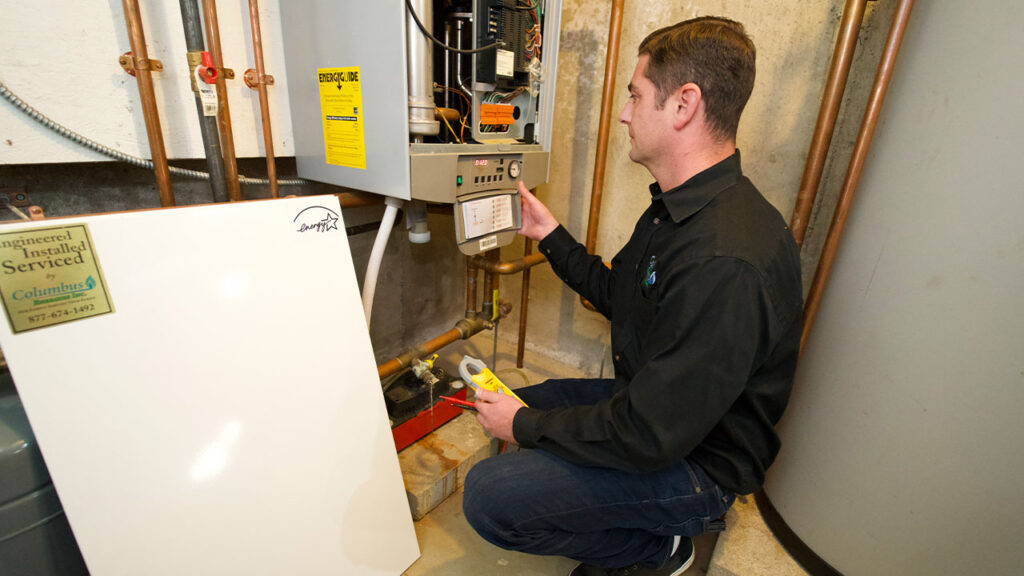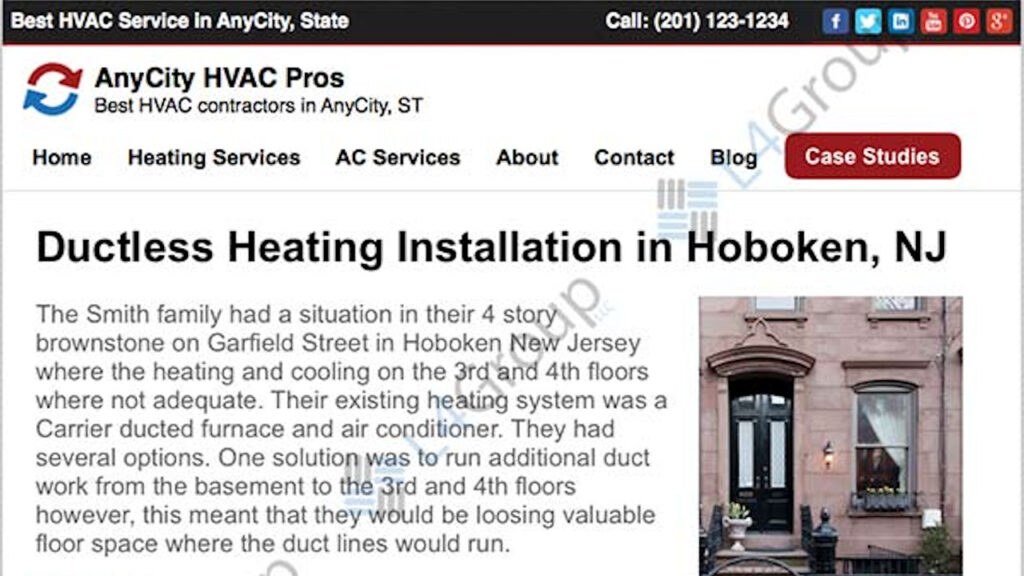Using Case Studies for HVAC Marketing
Brett Lewis
HVAC - October 10, 2023

Using case studies for HVAC marketing is a very effective and powerful technique to incorporate into your online marketing strategy. Think about this…
When your customers start to think about replacing their HVAC system, what is the first thing they do?
Typically homeowners will do one or both of the following actions.
- They will consult with their friends, family and/or coworkers to ask if they have worked with your company or if they have an HVAC system in their home that they would recommend.
- They will perform some online market research to see what other people are saying about the product in question or your company.
In today’s online, Internet-savvy world, 9 out of 10 people are relying on Google searches for online product and company reviews. They are also using Facebook, Twitter, and other social networks for posts from trusted friends related to your product and service.

The important takeaway is that consumers are using online tools like Google prior to making their purchasing decisions. The Internet has become a powerful tool, and consumers understand that a little bit of time invested in online research upfront can save them from making bad investment decisions.
HVAC case studies are a marketing tool that we highly, highly, highly encourage our customers to utilize. Case studies are an invaluable asset and an extremely powerful marketing and sales tool that allows you to establish proof to your customers that the heating and cooling systems you install are of high quality and will be a solid investment and increase the value of their home.
According to the Content Marketing Institute, marketers use 12 different marketing tactics on average, with case studies being the fifth most popular after social media content, eNewsletters, blogs, and website articles. It doesn’t stop there: The CMI also reports that 63% of UK marketers believe that case studies are effective marketing tactics. Similar statistics apply to the US market.
How To Build Case Studies To Market HVAC Services
In crafting a compelling case study for your HVAC business, it’s crucial to include specific components that highlight your expertise and the value you bring to clients. A well-structured case study not only showcases your successes but also serves as a persuasive tool to attract new business. Here are the key components to consider:
Introduction: Setting the Scene
Start with an introduction that sets the context. Briefly describe the client – whether it’s a residential homeowner, a commercial entity, or an industrial facility – and outline their initial situation or problem. This part should be engaging, aiming to resonate with your target audience by presenting a scenario they might find themselves in.
The Challenge: Detailing the Problem
This section is where you delve into the specific challenges your client faced. Was it an outdated heating system, inefficient cooling, poor air quality, or high energy costs? Detailing the problem helps potential clients relate to the situation and understand the complexities or typical issues that your business can address.
The Solution: Showcasing Your Approach
Here, you describe how your company tackled the client’s issue. Highlight the unique strategies or technologies you employed, the expertise of your team, and the steps taken to resolve the problem. It’s important to convey not just what you did, but how you did it differently or better than what might be expected in standard practice.
The Result: Quantifying the Success
The results section is critical as it demonstrates the tangible benefits you delivered. Use specific data and statistics to quantify improvements, such as increased energy efficiency, cost savings, or enhanced air quality. Before-and-after comparisons can be particularly effective. This section should solidify the value you provided and the impact of your solution.
Client Testimonial: Adding Credibility
Including a testimonial from the client adds a layer of trust and authenticity to your case study. Let the client speak about their experience, the professionalism of your team, and their satisfaction with the outcomes. This personal endorsement can be a powerful influence on potential customers.
Visual Elements: Enhancing Engagement
Incorporate photos, diagrams, or infographics to visually complement your narrative. Before-and-after shots, images of your team at work, or graphical representations of performance improvements can make the case study more engaging and easier to understand.

Incorporate Calls To Action
Be sure to optimize your case study with plenty of calls to action. Incorporate the types of calls to action that a potential buyer would be interested in. For example, a homeowner searching for solutions related to ductless heating and cooling may very well be interested in downloading a product guide for a ductless system.
Don’t stop with one call to action…
Readers will be in different stages of the marketing and sales cycle; for example, some will be in the research phase while others are entering the consideration phase. Be sure to include calls to action that will satisfy that reader’s goals. Here are some sample calls to action to use:
- Call (610) 471-0001 For A Complimentary Consultation
- Download Our Mitsubishi Product Guide
- Learn Why Ductless HVAC Is Perfect For Sun Rooms
- Schedule An In-Home Price Quote Today
- Book Your Next HVAC Tune-Up
- Save Money On Your HVAC Installation, Learn More Here
Conclusion: Wrapping Up with a Final Call to Action
End your case study with a strong conclusion that reinforces the effectiveness of your solution and invites the reader to take action. This could be an invitation to contact your company for a consultation, a prompt to learn more about your services on your website, or an encouragement to follow your business on social media for more updates.
Key Takeaways: Highlighting the Lessons
Finally, consider adding a section on key takeaways. Summarize the main lessons learned or underscore the unique aspects of the case that demonstrate your company’s strengths and capabilities. This helps in reinforcing your expertise and the value proposition you offer to potential clients.
Leverage your Heating and Cooling Case Studies: Get More Bang For Your Buck
In today’s competitive HVAC market, showcasing your expertise and reliability is crucial for standing out. Case studies, real-life examples of your work’s impact, are powerful tools in achieving this. They offer tangible proof of your skills, instilling confidence in potential clients. By integrating HVAC case studies into various facets of your marketing strategy, you can maximize their effectiveness and enhance your brand’s appeal.
Social Media: A Platform for HVAC Case Study Storytelling
Social media’s storytelling power makes it an ideal place to share your case studies. Platforms like Facebook, Instagram, and Twitter offer a wide audience, perfect for highlighting your successful projects. Share before-and-after photos, testimonials, and brief narratives about the challenges faced and how you overcame them. These posts can be engaging and shareable, expanding your reach organically. Use hashtags relevant to your industry to increase visibility and attract a targeted audience.
Blog Posts: Delving Deeper
Your website’s blog is a prime location for detailed case studies. Here, you can delve into the specifics of each project, discussing the problems, the solutions you provided, and the results in depth. This detailed approach helps in establishing your authority and expertise in the HVAC field. Additionally, well-written, informative blog posts can improve your website’s SEO, making you more visible on search engines.
LinkedIn: Networking with a Professional Touch
LinkedIn, the professional networking site, is another excellent platform for sharing case studies. By posting your case studies here, you can target industry professionals, including potential B2B clients. It’s a great place to demonstrate your capability to handle large and complex projects. Engage with your audience through LinkedIn articles or posts, encouraging discussions and fostering professional relationships.
Email Marketing: Direct and Personalized Communication
Incorporate your case studies into your email marketing campaigns. Send them to your subscribers as part of newsletters or as dedicated case study feature emails. Personalize these emails based on the recipient’s interests or needs, highlighting case studies most relevant to them. This approach not only keeps your existing customers engaged but also showcases your continued success to potential clients.
Video Marketing: Bringing Case Studies to Life
Videos are a compelling way to present case studies. Create short videos that highlight the key aspects of your projects and share them on platforms like YouTube, Instagram, and your website. Videos can be more engaging than text and are easily shareable, providing a broader reach. They offer a dynamic way to showcase your team in action, the problem-solving process, and the client’s testimonial, making your case studies more relatable and impactful.
Paid Advertising: Targeted Exposure
Utilize paid advertising on platforms like Google Ads or social media to promote your case studies. This method allows you to target specific demographics, geographical areas, or interests, ensuring that your case studies reach the most relevant audience. Use compelling visuals and strong call-to-actions in your ads to attract potential clients to your website.
Customer Presentations and Webinars
Finally, use your case studies in customer presentations and webinars. This approach is particularly effective in B2B scenarios, where detailed insights into your problem-solving abilities can significantly influence decision-makers. Webinars also offer an interactive platform to discuss your case studies, answer questions, and engage directly with potential clients.
By leveraging your heating and cooling case studies across these diverse channels, you not only demonstrate your expertise but also build trust with your audience. Each platform offers a unique way to present your success stories, ensuring that they resonate with a wide array of potential clients and industry peers. Remember, consistency in your messaging and regular updates of your case studies are key to keeping your content fresh and relevant.
Outsource Case Study Content Creation To L4 Group
- Does this sound awesome but like a lot of work?
- Do you see the benefit of utilizing case studies in your HVAC business but are thinking that you just don’t have the time to do this?
- Do you need to have this on your website immediately?
If so, you can leverage the resources of L4 Group. We build these types of case studies and integrate them into your website so that you don’t have to. You focus on what you do best, installing HVAC systems. Let us focus on telling your story and leveraging your story as a marketing tool for you to get more sales.
Existing customers of L4 Group can click the button below to access our case study entry page. If you would like us to create case studies for your company but you are not an L4 Group customer yet, give us a call at (610) 471-0001 to get started now.

